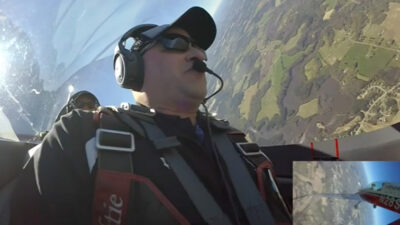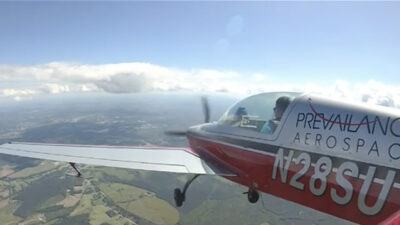Training Investments and Protecting Assets
You’ve made it. You finally have the airplane that you’ve always wanted. Whether that airplane is yours or your company’s, you worked hard to acquire it with a significant monetary investment.
Now that you have it, how do you protect it? Insurance? Of course. Premier maintenance? A must. Secure facility? Yes. Well-trained pilots? You certainly hope so…
These are the questions that you have to ask yourself when protecting such a valuable asset. But when evaluating pilots, how do you know what initial and recurrent training investment is required and what is desired to ensure the safest flights?
On-aircraft Upset Prevention & Recovery Training (UPRT) is being presented across the industry as a supplement to recurrent academic and simulator training. There is a growing recognition that on-aircraft UPRT may be the single best approach to significantly reduce the number of accidents each year that are attributed to Loss of Control Inflight (LOC-I). It appears that this facet of on-aircraft training fosters the necessary mental preparation that is lacking across the aviation industry.
In order to better understand this mental preparation, you have to look at the concepts of surprise and startle. Merriam-Webster defines surprise as “an unexpected event” while startle is “to agitate suddenly as by surprise.” Startle is further defined by the FAA in AC 120-111 as “an uncontrollable, automatic muscle reflex, raised heart rate, blood pressure, etc., elicited by exposure to a sudden, intense event that violates a pilot’s expectations.”1 This sudden, intense event, or surprise, could be as simple as the auto pilot kicking off or the stall warning horn sounding unexpectedly. Whatever the surprise is, it initiates the physiological, human response in each pilot which includes elevated heartbeat, increased blood pressure, adrenalin rush and generally an initial inability to focus. The only way to mentally prepare for startle is to experience surprise and manage the subsequent physiological response that occurs within one’s own body. Only by actually training to startle, can pilots learn to manage it.
On-aircraft UPRT does not diminish the reality or necessity of simulator training today, but it does address the very real aspects of surprise and startle when experiencing unusual attitudes and spins in an aircraft. The dynamic maneuvering associated with on-aircraft UPRT affects four of the five senses and can be disorienting. It also allows each pilot to recover; to experience startle and overcome it so that the first time doing so is not in a real emergency.
There is a long list of experienced pilots who should have known that their aircraft stalled and/or recognized the associated indications of a deviation from intended flight path. These pilots lost their lives and in many cases, those of their passengers, due to a LOC-I event. These pilots were well trained to the existing standard of training. Each did the recurrent academic and simulator training that was required. What they did not do is train their brains to manage startle.
Once a pilot recovers from an unusual attitude and a spin in an aircraft, then that pilot is better prepared to address recurrent training requirements, abiding by the limitations of each POH, in the simulator. Knowing what a recovery looks and feels like in an aircraft, each pilot will further seek the muscle memory of flying one’s own aircraft simulator through recovery procedures with the appropriate amount of controls input to manage pitch, roll and yaw deviations from intended flight path. On-aircraft training gives each pilot additional confidence in their own ability to recover with granularity that cannot be gained in a simulator alone. Separately, each pilot learns to manage startle.
The investment in on-aircraft training for each pilot is a fraction of what commercial, corporate and general aviation pilots are already paying for simulator training. In most cases, increasing a training budget by 10% will allow for the addition of this high fidelity training. That investment will make simulator work more effective and pilots better prepared to protect your assets.
1 U.S. Department of Transportation, Federal Aviation Administration, Advisory Circular 120-111, Upset Prevention and Recovery Training, 2015, https://www.faa.gov/documentLibrary/media/Advisory_Circular/AC_120-111.pdf

Prevailance Aerospace is a UPRT provider that has been working with corporate, government, and general aviation pilots to improve safety in the aviation industry. Prevailance Aerospace uses Extra 300 Series Aircraft for training and our pilots are experienced aviation professionals from various military and general aviation backgrounds. We know that successful aviation endeavors are accomplished through an uncompromising commitment to safety, impeccable professionalism, tremendous attention to detail, and constant improvement.
http://prevailanceaerospace.com
© 2025 Prevailance Aerospace. All Rights Reserved.
Next ArticleRelated Posts

Rise Up for the Next Generation
There is no doubt in my mind that flying is the way mankind is meant to travel, yet the continued success and growth of the industry requires a refined approach to safety. As someone who flies commercially and with a new interest in a career in aviation, I want the reassurance that the pilot in command (PIC) and crew are adequately prepared if and when an aircraft ends up in an upset.

Three Considerations That Set Pilots Up for Success
Constantly reviewing aviation accidents and incidents is challenging. As an instructor, it is not only the injuries and fatalities that make it hard, but the sheer magnitude of avoidable aspects of each incident. These safety reports prove that every Pilot in Command (PIC) is accountable for what transpires.

